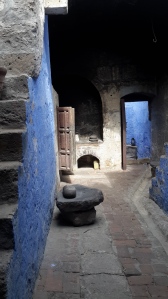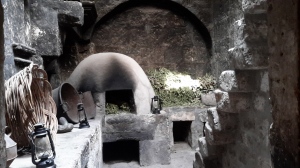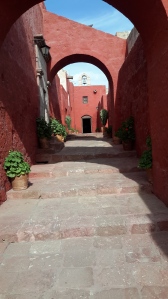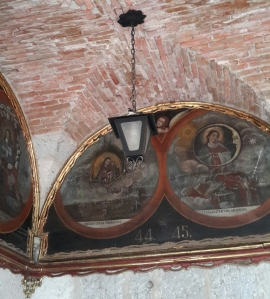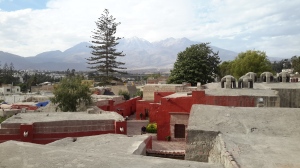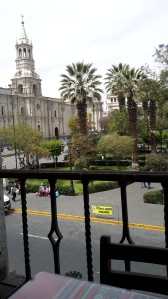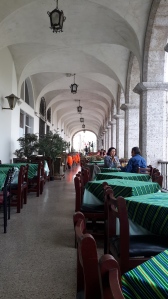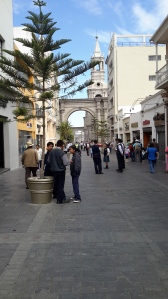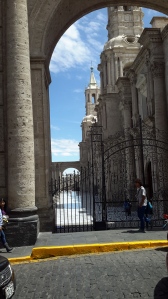Yesterday I arrived in Arequipa after a 16 hour overnight bus journey along the coast. I awoke in the morning to see the early morning sun shining on the coastal desert mountains and the first blue sky I have seen since landing in Peru. Arequipa is a huge contrast to Lima. Everything looks sunny, clean and bright. The climate is sunny, warm and dry year round. The main buildings in the city centre are made of Sillar stone, which is the local white stone and looks beautiful against the sunshine and bright blue sky. To add to the beauty of the city, it is surrounded by volcano mountains, the most prominent of which is El Misti. Wherever you go in the city you can see the mountains capped with snow glinting in the sun. The people of Arequipa consider themselves to be different from the rest of Peru. It seems to me that the place is like the California of Peru! The climate, the outdoor focus (with lots of trips to local canyons, mountains, Nazca lines), the Spanish colonial style buildings and the holiday atmosphere (it is full of tourists) all give it a laid back and fun atmosphere.
Yesterday I walked around the Santa Catalina Convent which is like a city within a city. The nuns came from wealthy families and had there own quarters and even servants during one period. They were and still are renowned for their baking and each nun had her own kitchen with huge stone oven and large pebble on a stone that they must have used for milling flour. There are still nuns there today but they don’t live it up like in colonial times. The Convent is vast and has streets and courtyards. The Sillar stone is painted in bright blue and orange and there are geraniums everywhere. In one courtyard a family of swifts was flying under the colonnade and I took a photo of one of them resting on a lantern.
Most exciting of all is that I booked a tour to trek the Colca Canyon. The tour is 3 days and 2 nights and we will see the volcanoes, wildlife on the pampas (llamas, alpacas, vicunas, viscachas which are related to chinchillas, and birds) villages in the canyon and the condors for which it is famous. We will be doing some trekking, mountain bike riding and swimming in thermal springs, as well as crossing a couple of rope bridges (I can beg out of the rope bridges if my vertigo kicks in). We will also be staying a night in a beautiful lodge on the mountainside that has panoramic views of the canyon from every bedroom.
So I will be staying another 2 days in Arequipa before going to the Colca Canyon on Thursday and then off to Cusco via Lake Titicaca.
Today I found Starbucks for my morning coffee and Wifi. I was sitting outside reading my Lonely Planet guide when some German travellers asked if they could join me on the only free sofas around. After a while I asked them in German about their travels. It was quite amusing to see their astonishment as they had obviously presumed they were having a private conversation. We had a chat about their travels as they have been to Cusco and Machu Picchu, and I was pleasantly surprised at how much German I could remember. Unlike my Spanish! So far I have mastered ‘can I book an extra night’ and ‘can I leave my backpack at reception’.
Arequipa has an altitude of 2,500 metres and I am feeling the effects of altitude, such as headache, dizziness and shortness of breath. So I am following my travel guide instructions and slowing down, resting and eating light meals and no Pisco sours. We will be at much higher altitudes trekking the Colca so hopefully this will acclimatize me in preparation.
One of the nicest things about Arequipa is that everywhere you look there are beautiful alpaca shops. I bought myself a very nice beanie and gloves of baby alpaca to keep warm on the treks. Just 5 minutes walk from my hostel is an alpaca shop where they also give you a tour of how they make the finished product. I saw some alpacas, both types including the suri which is long-haired and two types of llama. Apparently baby alpaca is what they call the hair that they take from the neck and back, as it is the finest. I got to feel some fleeces, including that of the wild vicuna that is even softer than baby alpaca. Vicunas were sacred to the Incas and are still protected. They are not domesticated and their hair is gathered during special hunt festivals when the Andean villagers round them up and let them go once they have taken some fleece. Only Inca nobles could wear vicuna cloth and nowadays it is extremely expensive. They had the most incredible designs of knitted clothes and accessories in their shop, but I just settled on some baby alpaca yarn to crochet with on my travels. Plenty of time to buy alpaca in Peru!
